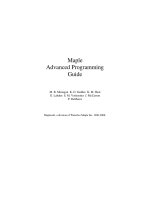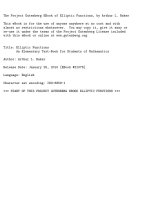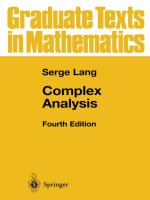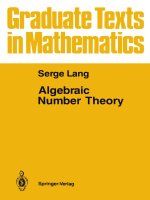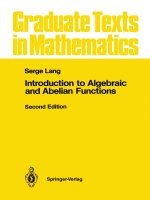Serge lang elliptic functions (1987) 978 1 4612 4752 4
Bạn đang xem bản rút gọn của tài liệu. Xem và tải ngay bản đầy đủ của tài liệu tại đây (27.36 MB, 319 trang )
Graduate Texts in Mathematics
Editorial Board
F. W. Gehring
P. R. Halmos
www.pdfgrip.com
112
Graduate Texts in Mathematics
I
2
3
4
S
6
7
8
9
JO
11
12
13
14
15
16
17
18
19
20
21
22
23
24
25
26
27
28
29
30
31
32
33
34
35
36
37
38
39
40
41
42
43
44
45
46
47
T AKEUTI/ZARING. Introduction to Axiomatic Set Theory. 2nd ed.
OXTOBY. Measure and Category. 2nd ed.
SCHAEFFER. Topological Vector Spaces.
HILTON/STAMMBACH. A Course in Homological Algebra.
MACLANE. Categories for the Working Mathematician.
HUGHES/PIPER. Projective Planes.
SERRE. A Course in Arithmetic.
T AKEUTI/ZARING. Axiomatic Set Theory.
HUMPHREYS. Introduction to Lie Algebras and Representation Theory.
COHEN. A Course in Simple Homotopy Theory.
CONWAY. Functions of One Complex Variable. 2nd ed.
BEALS. Advanced Mathematical Analysis.
ANDERSON/FuLLER. Rings and Categories of Modules.
GOLUBITSKy/GUILl.EMIN. Stable Mappings and Their Singularities.
BERBERIAN. Lectures in Functional Analysis and Operator Theory.
WINTER. The Structure of Fields.
ROSENBLATT. Random Processes. 2nd ed.
HALMOS. Measure Theory.
HALMOS. A Hilbert Space Problem Book. 2nd cd., revised.
HUSEMOLLER. Fibre Bundles. 2nd ed.
HUMPHREYS. Linear Algebraic Groups.
BARNES/MACK. An Algebraic Introduction to Mathematical Logic.
GRElJB. Linear Algebra. 4th ed.
HOLMES. Geometric Functional Analysis and its Applications.
HEWITT/STROMBERG. Real and Abstract Analysis.
MANES. Algebraic Theories.
KELLEY. General Topology.
ZARISKI/SAMUEL. Commutative Algebra. Vol. I.
ZARISKI/SAMlJEL. Commutative Algebra. Vol. II.
JACOBSON. Lectures in Abstract Algebra I: Basic Concepts.
JACOBSON. Lectures in Abstract Algebra II: Linear Algebra.
JACOBSON. Lectures in Abstract Algebra III: Theory of Fields and Galois Theory.
HIRSCH. Differential Topology.
SPITZER. Principles of Random Walk. 2nd ed.
WERMER. Banach Algebras and Several Complex Variables. 2nd cd.
KELl.Ey/NAMIOKA et aJ. Linear Topological Spaces.
MONK. Mathematical Logic.
GRAUERT/FRITLSCHE. Several Complex Variables.
ARVESON. An Invitation to C*-Algebras.
KEMENy/SNELL/KNAPP. Denumerable Markov Chains. 2nd ed.
APOSTOL. Modular Functions and Dirichlet Series in Number Theory.
SERRE. Linear Representations of Finite Groups.
GILLMAN/JERISON. Rings of Continuous Functions.
KENDIG. Elementary Algebraic Geometry.
LOEVE. Probability Theory I. 4th ed.
LOEVE Probability Theory II. 4th ed.
MOISE. Geometric Topology in Dimensions 2 and 3.
continued after Index
www.pdfgrip.com
Serge Lang
Elliptic Functions
Second Edition
Springer-Verlag
New York Berlin Heidelberg
London Paris Tokyo
www.pdfgrip.com
Serge Lang
Department of Mathematics
Yale University
New Haven, CT 06520
U.S.A.
Editorial Board
F. W. Gehring
Department of Mathematics
University of Michigan
Ann Arbor, MI 48109
U.S.A.
P. R. Halmos
Department of Mathematics
Santa Clara University
Santa Clara, CA 95053
U.S.A.
AMS Classifications: lOD05, 12B25
Library of Congress Cataloging in Publication Data
Lang, Serge
Elliptic functions.
(Graduate texts in mathematics; 112)
Bibliography: p.
1. Functions, Elliptic. I. Title.
QA343.L35 1987
515.9'83
87-4514
The first edition of this book was published by Addison-Wesley Publishing Company, Inc.,
Reading, MA, in 1973.
© 1987 by Springer-Verlag New York Inc.
Softcover reprint of the hardcover 1st edition 1987
All rights reserved. This work may not be translated or copied in whole or in part without the
written permission of the publisher (Springer-Verlag, 175 Fifth Avenue, New York, New York
10010, U.S.A.), except for brief excerpts in connection with reviews or scholarly analysis. Use in
connection with any form of information storage and retrieval, electronic adaptation, computer
software, or by similar or dissimilar methodology now known or hereafter developed is forbidden.
9 8 7 6 543 2 1
ISBN-13: 978-1-4612-9142-8
e-ISBN-13: 978-1-4612-4752-4
DOl: 10.1007/978-1-4612-4752-4
www.pdfgrip.com
Preface
Elliptic functions parametrize elliptic curves, and the intermingling of the
analytic and algebraic-arithmetic theory has been at the center of mathematics
since the early part of the nineteenth century.
Some new techniques and outlooks have recently appeared on these old
subjects, continuing in the tradition of Kronecker, Weber, Fricke, Hasse,
Deuring. Shimura's book Introduction to the arithmetic theory of automorphic
functions is a splendid modern reference, which I found very helpful myself to
learn some aspects of elliptic curves. It emphasizes the direction of the HasseWeil zeta function, Hecke operators, and the generalizations due to him to the
higher dimensional case (abelian varieties, curves of higher genus coming from
an arithmetic group operating on the upper half plane, bounded symmetric
domains with a discrete arithmetic group whose quotient is algebraic). I refer
the interested reader to his book and the bibliography therein.
I have placed a somewhat different emphasis in the present exposition. First,
I assume less of the reader, and start the theory of elliptic functions from
scratch. I do not discuss Hecke operators, but include several topics not covered
by Shimura, notably the Deuring theory of t -adic and p-adic representations;
the application to Ihara's work; a discussion of elliptic curves with non-integral
invariant, and the Tate parametrization, with the applications to Serre's work
on the Galois group of the division points over number fields, and to the isogeny
theorem; and finally the Kronecker limit formula and the discussion of values
of special modular functions constructed as quotients of theta functions, which
are better than values of the Weierstrass function because they are units when
properly normalized, and behave in a specially good way with respect to the
action of the Galois group.
Thus the present book has a very different flavor from Shimura's. It was
unavoidable that there should be some non-empty overlapping, and I have
chosen to redo the complex multiplication theory, following Deuring's algebraic
method, and reproducing some ofShimura's contributions in this line (with some
v
www.pdfgrip.com
VI
PREFACE
simplifications, e.g. to his reciprocity law at fixed points, and with another proof
for the theorem concerning the automorphisms of the modular function field).
I do not emphasize elliptic curves in characteristic p, except as they arise by
reduction from characteristic O. Thus I have omitted most of the theory proper
to characteristic p, especially the finer theory of supersingular invariants. The
reader should be warned, however, that this theory is important for the deeper
analysis of the arithmetic theory of elliptic curves. The two appendices should
help the reader get into the literature.
I thank Shimura for his patience in explaining to me some facts about his
research; Eli Donkar for his notes of a course which provided the basis for the
present book; Swinnerton-Dyer and Walter Hill for their careful reading of the
manuscript.
New Haven, Connecticut
SERGE LANG
Note for the Second Edition
I thank Springer-Verlag for keeping the book in print. It is unchanged
except for the corrections of some misprints, and two items:
1. John Coates pointed out to me a mistake in Chapter 21, dealing with the
L-functions for an order. Hence I have eliminated the reference to orders at that
point, and deal only with the absolute class group.
2. I have renormalized the functions in Chapter 19, following Kubert-Lang.
Thus I use the Klein forms and Siegel functions as in that reference. Actually, the
final formulation of Kronecker's Second Limit Formula comes out neater under
this renormalization.
S. L.
November 1986
www.pdfgrip.com
Contents
PART ONE
GENERAL THEORY
Chapter 1 Elliptic Functions
1 The Liouville Theorems.
2 The Weierstrass Function
3 The Addition Theorem
4 Isomorphism Classes of Elliptic Curves
5 Endomorphisms and Automorphisms .
Chapter 2
23
25
28
Points of Finite Order
The Modular Function
1 The Modular Group.
2 Automorphic Functions of Degree 2k .
3 The Modular Function j.
Chapter 4
12
14
19
Homomorphisms
2 Isogenies
3 The Involution
Chapter 3
5
7
29
32
39
Fourier Expansions
Expansion for Gk, g2, g3, A andj
2 Expansion for the Weierstrass Function
3 Bernoulli Numbers
Vll
www.pdfgrip.com
43
45
48
CONTENTS
VI11
Chapter 5 The Modular Equation
Integral Matrices with Positive Determinant
2 The Modular Equation
3 Relations with Isogenies .
51
54
58
Chapter 6 Higher Levels
1 Congruenc~ Subgroups
2 The Field of Modular Functions Over C
3 The Field of Modular Functions Over Q .
4 Subfields of the Modular Function Field .
61
62
65
72
Chapter 7 Automorphisms of the Modular Function Field
1 Rational Adeles of GL 2 •
2 Operation of the Rational Adeles on the Modular Function
Field
3 The Shimura Exact Sequence .
PART TWO
75
77
83
COMPLEX MULTIPLICATION
ELLIPTIC CURVES WITH SINGULAR INVARIANTS
Chapter 8 Results from Algebraic Number Theory
1
2
3
4
Chapter 9
Lattices in Quadratic Fields
Completions
The Decomposition Group and Frobenius Automorphism.
Summary of Class Field Theory
89
98
101
107
Reduction of Elliptic Curves
Non-degenerate Reduction, General Case
2 Reduction of Homomorphisms.
3 Coverings of Level N
4 Reduction of Differential Forms
111
112
113
117
Chapter 10 Complex Multiplication
1 Generation of Class Fields, Deuring's Approach
2 Idelic Formulation for Arbitrary Lattices.
3 Generation of Class Fields by Singular Values of Modular
Functions.
4 The Frobenius Endomorphism.
Appendix A Relation of Kronecker
www.pdfgrip.com
123
129
132
136
143
CONTENTS
Chapter 11
1
ix
Shimura's Reciprocity Law
Relation Between Generic and Special Extensions
2 Application to Quotients of Modular Forms.
149
153
Chapter 12 The Function A(cx't)/ A('t)
1 Behavior Under the Artin Automorphism
2 Prime Factorization of its Values
3 Analytic Proof for the Congruence Relation of j .
161
163
168
Chapter 13 The {-adic and p-adic Representations of Deuring
1 The r-adic Spaces
2 Representations in Characteristic p
3 Representations and Isogenies
4 Reduction of the Ring of Endomorphisms
5 The Deilring Lifting Theorem
172
174
178
181
184
Chapter 14 Ihara's Theory
1 Deuring Representatives
2 The Generic Situation
3 Special Situations.
187
190
191
PART THREE ELLIPTIC CURVES WITH NON-INTEGRAL
INVARIANT
Chapter 15 The Tate Parametrization
1 Elliptic Curves with Non-integral Invariants
2 Elliptic Curves Over a Complete Local Ring.
197
202
Chapter 16 The Isogeny Theorems
1
2
3
4
5
Chapter 17
The Galois p-adic Representations.
Results of Kummer Theory.
The Local Isogeny Theorems
Supersingular Reduction
The Global Isogeny Theorems
205
208
211
213
216
Division Points Over Number Fields
1 A Theorem of Shafarevic
2 The Irreducibility Theorem .
www.pdfgrip.com
221
225
x
CONTENTS
3 The Horizontal Galois Group
4 The Vertical Galois Group
5 End of the Proof
226
229
231
PART FOUR THETA FUNCTIONS AND KRONECKER LIMIT
FORMULA
Chapter 18 Product Expansions
2
3
4
5
6
The Sigma and Zeta Function
Appendix The Skew Symmetric Pairing
A Normalization and the q-product for the (T-function
q-expansions Again .
The q-product for A .
The Eta Function of Dedekind .
Modular Functions of Level 2 .
239
243
246
248
249
252
254
Chapter 19 The Siegel Functions and Klein Forms
The Klein Forms.
2 The Siegel Functions
3 Special Values of the Siegel Functions
259
262
264
Chapter 20 The Kronecker Limit Formulas
2
3
4
5
The Poisson Summation Formula
Examples .
The Function Ks(x) .
The Kronecker First Limit Formula
The Kronecker Second Limit Formula
Chapter 21
The First Limit Formula and L-series
1 Relation with L-series
2 The Frobenius Determinant.
3 Application to the L-series .
Chapter 22
267
268
270
273
276
279
282
284
The Second Limit Formula and L-series
1 Gauss Sums .
2 An Expression for the L-series .
www.pdfgrip.com
287
289
CONTENTS
APPENDICES
Appendix 1
ELLIPTIC CURVES IN CHARACTERISTIC p
Algebraic Formulas in Arbitrary Characteristic
By J.
TATE
1 Generalized Weierstrass Form
Canonical Forms
Expansion Near 0; The Formal Group
2
3
Appendix 2
Xl
299
301
304
The Trace of Frobenius and the Differential of First Kind
The Trace of Frobenius .
Duality
3 The Tate Trace .
4 The Cartier Operator
5 The Hasse Invariant.
2
307
308
309
311
316
Bibliography
321
Index .
325
www.pdfgrip.com
Part One
General Theory
www.pdfgrip.com
In this part we study elliptic curves, which can be defined by the Weierstrass
equation y2 = 4x 3 - g2X - g3' We shall see that their complex points form
a commutative group, which is complex analytically isomorphic to a complex
torus CjL, where L is a lattice in C. We study these curves in general, especially
those which are "generic". We consider their homomorphisms, isomorphisms,
and their points of finite order in general. We also relate such curves with
modular functions, and show how to parametrize isomorphism classes of curves
by points in the upper half plane modulo SL 2 (Z). We constantly interrelate the
transcendental parametrizations with the algebraic properties involved. Our
policy is to tell the reader what is true in arbitrary characteristic (due to Hasse),
and give the short proofs mostly only in characteristic 0, using the transcendental
parametrization.
www.pdfgrip.com
1
Elliptic Functions
§1. THE LIOUVILLE THEOREMS
By a lattice in the complex plane C we shall mean a subgroup which is free
of dimension 2 over Z, and which generates C over the reals. If w!> Wz is a basis
of a lattice Lover Z, then we also write L = [Wt, wzl. Such a lattice looks like
this:
Fig. 1-1
Unless otherwise specified, we also assume that Im(wdwz) > 0, i.e. that wdwz
lies in the upper half plane ~ = {x + iy, y > O}. An elliptic function f (with
respect to L) is a meromorphic function on C which is L-periodic, i.e.
fez
+ w) = fez)
5
www.pdfgrip.com
6
ELLIPTIC FUNCTIONS
for all z
E
[1, §l]
e and W E L. Note thatfis periodic if and only if
fez + WI) = fez) = fez + (2)'
An elliptic function which is entire (i.e. without poles) must be constant,
because it can be viewed as a continuous function on elL, which is compact
(homeomorphic to a torus), whence the function is bounded, and therefore
constant.
If L = [WI' W2] as above, and rx E e, we call the set consisting of all points
rx + t I W I + t 2 w 2 ,
0 ~ ti ~ 1
a fundamental parallelogram for the lattice (with respect to the given basis).
We could also take the values 0 ~ ti < 1 to define a fundamental parallelogram,
the advantage then being that in this case we get unique representatives for
elements of CfL in C.
Theorem 1. Let P be a fundamental parallelogram for L, and assume that
the elliptic function f has no poles on its boundary GP. Then the sum of the
residues off in P is O.
Proof' We have
2ni L Res
f =
f
ap
fez) dz = 0,
this last equality being valid because of the periodicity, so the integrals on
opposite sides cancel each other.
Fig. 1·2
a
An elliptic function can be viewed as a merom orphic function on the torus
CfL, and the above theorem can be interpreted as saying that the sum of the
residues on the torus is equal to O. Hence:
Cor 0 II a r y. An elliptic function has at least two poles (counting multiplicities)
on the torus.
Theorem 2. Let P be a fundamental parallelogram, and assume that the
elliptic function f has no zero or pole on its boundary. Let {a;} be the singular
points (zeros and poles) off inside P, and let f have order mi at ai' Then
Lmi =0.
www.pdfgrip.com
[1, §2]
THE WEIERSTRASS FUNCTION
7
Proof Observe that/elliptic implies that!, and!'f/are elliptic. We then
obtain
o~
r
Jap
l' !f(z) dz =
27tJ-=1
L Residues = 2nJ-=1 L mi'
thus proving our assertion.
Again, we can formulate Theorem 2 by saying that the sum of the orders of
the singular points of/ on the torus is equal to O.
Theorem 3. Hypotheses being as in Theorem 2, we have
L miai == 0 (mod L).
Proof This time, we take the integral
r
JoP
Z
f'(z)
fez) dz = 2nJ -1
L miai>
because
f'(z)
resa , z fez) = miai'
On the other hand we compute the integral over the boundary of the parellelogram by taking it for two opposite sides at a time. One pair of such integrals
is equal to
f
"+Wl f'(z)
"
Z
f( ) dz -
f"+Wl +W2 f'(z)
Z
z f( ) dz.
"+W2
Z
We change variables in the second integral, letting u = z - CO2' Both integrals
are then taken from IX to IX + COl, and after a cancellation, we get the value
f
"+ W1 f'(U)
- CO 2 "
feu) du
=
2nJ -1
kC02'
for some integer k. The integral over the opposite pair of sides is done in the
same way, and our theorem is proved.
§2. THE WEIERSTRASS FUNCTION
We now prove the existence of elliptic functions by writing some analytic
expression, namely the Weierstrass function
,f.J(z) = \
z
+ weL'
L [(Z
-
1 )2 CO
www.pdfgrip.com
~J,
CO
8
[1, §2]
ELLIPTIC FUNCTIONS
where the sum is taken over the set of all non-zero periods, denoted by L'.
We have to show that this series converges uniformly on compact sets not
including the lattice points. For bounded z, staying away from the lattice points,
the expression in the brackets has the order of magnitude of l/lwl 3 • Hence it
suffices to prove:
Lemma. If A. > 2, then
1
L I-I)' converges.
OJeL' W
Proof The partial sum for Iwi ;a; N can be decomposed into a sum for w
in the annulus at n, i.e. n - 1 ;a; Iwl ;a; n, and then a sum for 1 ;a; n ;a; N.
In each annulus the number of lattice points has the order of magnitude n.
Hence
1
L
Iwl). ~
IOJI~N
oon
L
1
n)'
~
00
1
L n).-l
1
which converges for A. > 2.
The series expression for f.J shows that it is meromorphic, with a double
pole at each lattice point, and no other pole. It is also clear that f.J is even, i.e.
f.J(z) = f.J( - z)
(summing over the lattice points is the same as summing over their negatives).
We get f.J' by differentiating term by term,
a.J'(z) = -2
the sum being taken for all w
E
L(
1 )3'
weLZ-W
L. Note that f.J' is clearly periodic, and is odd, i.e.
f.J'( - z)
= -
f.J'(z).
From its periodicity, we conclude that there is a constant C such that
f.J(z
+ WI)
= f.J(z)
+ C.
Let Z = -W1/2 (not a pole of f.J). We get
and since f.J is even, it follows that C = O. Hence f.J is itself periodic, something
which we could not see immediately from its series expansion.
It is clear that the set of all elliptic functions (with respect to a given lattice
L) forms a field, whose constant field is the complex numbers.
Theorem 4. The field of elliptic functions (with respect to L) is generated
by f.J and f.J •
www.pdfgrip.com
[1, §2]
9
THE WEIERSTRASS FUNCTION
Proof Iff is elliptic, we can write f as a sum of an even and an odd elliptic
function as usual, namely
f( ) - fez)
z -
+
2
f( -z)
+
fez) - f( -z)
2
.
Iff is odd, then the product 1&0 is even, so it will suffice to prove that C(f.J) is
the field of even elliptic functions, i.e. iffis even, thenfis a rational function of f.J.
I
Suppose that f is even and has a zero of order m at some point u. Then clearly
f also has a zero of the same order at - u because
j
= (_l)kj
Similarly for poles.
If u == -u (mod L), then the above assertion holds in the strong sense,
namely f has a zero (or pole) of even order at u.
Proof First note that u
== -
u (mod L) is equivalent to
2u
== 0 (mod L).
On the torus, there are exactly four points with this property, represented by
o 001
002 001
, 2' 2'
+ 002
2
in a period parallelogram. Iffis even, thenf' is odd, i.e.
f'(u) = -1'( -u).
Since u == - u (mod L) andf' is periodic, it follows thatf'(u) = 0, so thatfhas
a zero of order at least 2 at u. If u ¢ 0 (mod L), then the above argument shows
that the function
g(z) = f.J(z) - f.J(u)
has a zero of order at least 2 (hence exactly 2 by Theorem 2 and the fact that &0
has only one pole of order 2 on the torus). Thenf /g is even, elliptic, holomorphic
at u. Iff(u)/g(u) # 0 then orduf = 2. Iff(u)/g(u) = 0 thenflg again has a zero
of order at least 2 at u and we can repeat the argument. If u == 0 (mod L) we
use g = 1/f.J and argue similarly, thus proving thatfhas a zero of even order
at u.
Now let Ui (i = 1, ... , r) be a family of points containing one representative
from each class (u, -u) (mod L) wherefhas a zero or pole, other than the class
of L itself. Let
if 2Ui ¢ 0 (mod L),
mi = ord",f
mi =
1- ord .. , f
if
2Ui
== 0 (mod L).
Our previous remarks show that for a E C, a ¢ 0 (mod L), the function
www.pdfgrip.com
10
[1, §2]
ELLIPTIC FUNCTIONS
so(z) - so(a) has a zero of order 2 at a if and only if 2a == 0 (mod L), and has
distinct zeros of order 1 at a and - a otherwise. Hence for all z =1= 0 (mod L)
the function
n [SO(z) r
SO(uJr
i= 1
has the same order at z as f This is also true at the origin because of Theorem 2
applied to f and the above product. The quotient of the above product by f is
then an elliptic function without zero or pole, hence a constant, thereby proving
Theorem 4.
Next, we obtain the power series development of SO and go' at the origin,
from which we shall get the algebraic relation holding between these two functions. We do this by brute force.
SO(z) = 21
Z
1
z
= 2
+ L
WEL'
+
[ 21 ( 1
Q)
L L
00
wEL'm=l
)2
+ -z + (z)2
- +. . . Q)
(m
+
Q)
(z)m 21
1) -Q)
Q)
where
Note that em = 0 if m is odd.
Using the notation
we get the expansion
1
SO(z) = 2
Z
+ L
00
(2n
+
1)S2n+zCL)z2n,
n=l
from which we write down the first few terms explicitly:
and differentiating term by term,
www.pdfgrip.com
21 ]
Q)
[1, §2]
11
THE WEIERSTRASS FUNCTION
Theorem 5. Let 92 = 92(L) = 60s4 and 93 = 93(L) = 140s6 • Then
p'2 = 4 p 3 - 9zP - 93'
Proof We expand out the function
+ 92&{}(Z) + 93
cp(z) = p'(z)z - 4&,J(Z)3
at the origin, paying attention only to the polar term and the constant term.
This is easily done, and one sees that there is enough cancellation so that these
terms are 0, in other words, cp(z) is an elIiptic function without poles, and with
a zero at the origin. Hence (p is identicalIy zero, thereby proving our theorem.
The preceding theorem shows that the points (p(z), p'(z» lie on the curve
defined by the equation
y2 =
4x 3
-
9z X
-
93'
The cubic polynomial on the right-hand side has a discriminant given by
Ll = 9} - 279~.
We shall see in a moment that this discriminant does not vanish.
Let
i = 1,2,3,
where L
= [WI' Wz]
and
W3 = WI
+ W z. Then the function
h(z) = p(z) - ei
has a zero at wJ2, which is of even order so that &{}'(wJ2) = 0 for i = 1,2, 3,
by previous remarks. Comparing zeros and poles, we conclude that
Thus e l , ez, e3 are the roots of 4x 3 - 9zX - 93' Furthermore, p takes on the
value ei with multiplicity 2 and has only one pole of order 2 mod L, so that
e i #- ej for i #- j. This means that the three roots of the cubic polynomial are
distinct, and therefore
Ll = 9} - 279~ #- O.
www.pdfgrip.com
12
[1, §3]
ELLIPTIC FUNCTIONS
§3. THE ADDITION THEOREM
Given complex numbers g2, g3 such that gq - 27g~ #- 0, one can ask
whether there exists a lattice for which these are the invariants associated to the
lattice as in the preceding section. The answer is yes, and we shall prove this in
chapter 3. For the moment, we consider the case when g2, g3 are given as in the
preceding section, i.e. g2 = 60s4 and g3 = 140s 6·
We have seen that the map
Z I--> (I, 6;J(Z), &;J'(z»
parametrizes points on the cubic curve A defined by the equation
y2 = 4 X3 - g2 X - g3'
This is an affine equation, and we put in the coordinate 1 to indicate that we
also view the points as embedded in projective space. Then the mapping is
actually defined on the torus CjL, and the lattice points, i.e. 0 on the torus, are
precisely the points going to infinity on the curve. Let A c denote the complex
points on the curve. We in fact get a bijection
CjL - {OJ -> Ac - {oo}.
This is easily seen: For any complex number'Y.,gu(z) - 'Y. has at most two zeros,
and at least one zero, so that already under g.J we cover each complex number 'Y..
It is then verified at once that using g;)' separates the points ofCjL lying above 'Y.,
thus giving us the bijection. If you know the terminology of algebraic geometry,
then you know that the curve defined by the above equation is non-singular,
and that our mapping is actually a complex analytic isomorphism between
CjL and Ac.
Furthermore, CjL has a natural group structure, and we now want to see
what it looks like when transported to A. We shall see that it is algebraic. In
other words, if
and
PI = (XI' YI),
P 2 = (X2, Y2),
P 3 = (X3' Y3)
P 3 = PI + P 2,
then we shall express X3, Y3 as rational functions of (Xl' YI) and (X2' Yz). We
shall see that P 3 is obtained by taking the line through PI, P 2, intersecting it
with the curve, and reflecting the point of intersection through the x-axis, as
shown on Fig. 3.
Select Ut. U z E C and rf: L, and assume UI ;:fo U z (mod L). Let a, b be complex
numbers such that
gu'(U I ) = ag;J(u I ) + b
gu'(uz) = ag;J(uz) + b,
in other wordsy = ax + b is the line through (f;J(Uj),gu'(u l and (gu(uz)' gu'(U2))'
Then
gu'(z) - (agu(z) + b)
»)
www.pdfgrip.com
[1, §3)
13
THE ADDITION THEOREM
has a pole of order 3 at 0, whence it has three zeros, counting multiplicities,
and two of these are at U I and U2' If, say, U I had multiplicity 2, then by Theorem
3 we would have
+
2u I
U2
==
°(mod
L).
Fig. 1-3
If we fix U 1 , this can hold for only one value of U 2 . Let us assume that we do
not deal with this value. Then both U I , U 2 have multiplicity 1, and the third
zero lies at
U3 == -CUI + u 2 ) (mod L)
again by Theorem 3. So we also get
&;.>'(U3) = ag;.>(u3)
The equation
4x 3 - g2X - g3 - (ax
+ b.
+ b)2
=
°
has three roots, counting multiplicities. They are 8;.>(U I ), g;'>(U2), P(U3), and the
left-hand side factors as
4(x - g;'>(UI»(X - gJ(u 2»(x - 8;J(U3»'
Comparing the coefficient of x 2 yields
+
P(Ul)
g;.>(u 2)
+
P(U3) =
a2
4'
But from our original equations for a and b, we have
a(g;.>(u 1 )
-
gO(U2» = &;.>'(Ul) - p'(u 2)·
www.pdfgrip.com
14
[1, §4]
ELLIPTIC FUNCTIONS
Therefore from
we get
1_ _ _ _ _ _ _ _ _ _ _ _ _ _ _ _ _ _ _ _ _ _ _ _ _ _ _ _ _ __ _ _
or in algebraic
terms~3 ~
-Xl _ X2
+ ~(YI
_Yz)2
4
X2
Xl -
Fixing U 1 , the above formula is true for all but a finite number ofu2
whence for all U z i= Ul (mod L) by analytic continuation.
For U 1 == U2 (mod L) we take the limit as Ul -> Uz and get
go(2u) = -2go(u)
i=
U1
(mod L).
J "(U»)2
+ -1(cf-
4 go'(u)
These give us the desired algebraic addition formulas. Note that the formulas
involve only g2, g3 as coefficients in the rational functions.
This is as far as we shall push the study of the &J-function in general, except
for a Fourier expansion formula in Chapter 4. For further information, the
reader is referred to Fricke [B2]. For instance one can get formulas for go(nz),
one can get a continued fraction expansion (done by Frobenius), etc. Classics
like Fricke still contain much information which has not yet reappeared in more
modern books, nor been made much use of, although history shows that everything that has been discovered along those lines ultimately returns to the center
of the stage at some point.
§4. ISOMORPHISM CLASSES OF ELLIPTIC CURVES
Theorem 6. Let L, M be two lattices in C and let
.Ie: CjL -> CjM
be a complex analytic homomorphism. Then there exists a complex number a
such that the following diagram is commutative.
"
C ----+
C
1 1
Cj L ----+ Cf M
;.
www.pdfgrip.com
[I, §4]
ISOMORPHISM CLASSES OF ELLIPTIC CURVES
15
The top map is multiplication by rx, and the vertical maps are the canonical
homomorphisms.
Proof Locally near 0, ), can be expressed by a power series,
}(z) = aD
+
a1z
+
a2z2
+ ... ,
and since a complex number near 0 represents uniquely its class mod L, it
follows from the formula
).(z + Zl) == i(z) + A(Z') (mod M)
that the congruence can actually be replaced by an equality. Hence we must have
}.(z) = a1z,
for z near O. But z/n for arbitrary z and large n is near 0, and from this one
concludes that for any z we must have
This proves our theorem.
),(z) == a1z (mod M).
We see that A is represented by a multiplication rx, and that
rxLe M.
Conversely, given a complex number rx and lattices L, M such that rxL e M,
multiplication by rx induces a complex analytic homomorphism of C/L into C/ M.
Two complex toruses C/L and C/ M are isomorphic if and only if there
exists a complex number rx such that rxL = M. We shall say that two lattices
L, M are linearly equivalent if this condition is satisfied. In the next chapter,
we shall find an analytic invariant for equivalence classes of lattices.
By an elliptic curve, or abelian curve A, one means a complete non-singular
curve of genus 1, and a special point 0 taken as origin. The Riemann-Roch
theorem defines a group law on the group of divisor classes of A. Actually, if
P, P' are points on A, then there exists a unique point P" such that
(P)
+
(P') ~ (P")
+
(0),
where ~ means linear equivalence, i.e. the left-hand side minus the right-hand
side is the divisor of a rational function on the curve. The group law on A is
then P + P' = plf. In characteristic i= 2 or 3, using the Riemann-Roch theorem,
one finds that the curve can be defined by a Weierstrass equation
y2 = 4x 3 - g2 X - g3,
with g2, g3 in the ground field over which the curve is defined. Conversely, any
homogeneous non-singular cubic equation has genus 1 and defines an abelian
curve in the projective plane, once the origin has been selected. These facts
depend on elementary considerations of curves. A curve defined by equations in
projective space is said to be defined over a field k if the coefficients of these
equations lie in k. For the Weierstrass equation, this means g2, g3 E k.
www.pdfgrip.com
